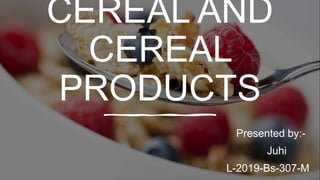
microbiology of cereal and cereal products
- 2. CEREALS • Cereals belong to the Gramineae or the grass family, are one of the most important sources of carbohydrates in the human diet. • The seven principle cereals grown in the world are wheat, maize, rice, barley, oats, rye and sorghum. • Wheat, rice and maize are by far the most important cereal crops on the basis of world-wide production.
- 3. Factors governing the microbiology of cereals • INTRINSIC PARAMETERS • FACTORS LIKE ACIDITY, WATER ACTIVITY, REDOX POTENTIAL AND AVAILABLE NUTRIENTS. • INHERENT PROPERTIES OF FOOD ITSELF. • EXTRINSIC PARAMETERS • ENVIRONMENT WHERE THE FOOD IS STORED. • TEMPERATURE, HUMIDITY AND ATMOSPHERIC CONDITIONS.
- 4. microbiology of cereals • The microbial flora of wheat, rye, corn, and related products may be expected to be that of soil, storage environments, and those picked up during the processing of these commodities • Water activity and temperature are the most important environmental factors which determine growth of microbes on cereals and its products. • Although these products are high in proteins
- 5. Microbiol ogy of cereals Moisture content above 12-13 percent may cause spoilage of cereals. Little moisture causes mould growth and high moisture may cause yeast and bacterial growth. Common moulds causing spoilage includes-- Aspergillus, Penicillium, Mucor, Rhizopus and Fusarium. Common bacterial species causing spoilage includes—acetobacter spp, Micrococci, Bacillus and some coliforms.
- 6. Microbiol ogy of cereals xerophilic moulds such as Eurotium spp. and Aspergillus restrictus may grow very slowly at the lower limit of their water activity range (14%) once they start growing and metabolizing they will produce water of respiration and the local water activity will steadily rise allowing more rapid growth. Indeed it will allow mesophilic mould spores to germinate and grow. There is a sequence of observable consequences of the process of mould growth on cereals starting with a decrease in germinability of the grain. This is followed by discolouration, the production of mould metabolites including mycotoxins, demonstrable increase in temperature (self- heating), the production of musty odours, caking and a rapid increase in water activity leading finally to the complete decay with the growth of a wide range of microorganisms like bacteria and yeast.
- 7. Many aerobic spore formers are capable of producing amylase, which enables them to utilize flour and related products as sources of energy, provided that sufficient moisture is present to allow growth to occur. With less moisture, mould growth occurs and may be seen as typical mycelial growth and spore formation. Members of the genus Rhizopus are common and may be recognized by their black spores.
- 8. Cereal products CEREAL GRAINS • If the water activity increases above 0.6, some of the species of fungi (Aspergillus, Penicillium and Rhizopus) can grow and cause spoilage • Yeasts are common on all cereals, although they represent only a minority of microbial flora. REFRIGERATED DOUGH (Biscuits, rolls and pizza dough) • Susceptible to spoilage (gas formation) from the growth of psychrotrophic heterolactic species of Lactobacillus and Leuconostoc which can blow up the containers.
- 9. breads • Commercially produced and properly handled bread generally lacks sufficient amounts of moisture to allow for the growth of any organisms except moulds. One of the most common is Rhizopus stolonifer, often referred to as the "bread mould." The "red bread mould," Neurospora sitophila, may also be seen from time to time. Storage of bread under conditions of low humidity retards mould growth, and this type of spoilage is generally seen only when bread is stored in high humidity or when wrapped while still warm. • Homemade breads may undergo a type of spoilage known as ropiness, which is caused by the growth of certain strains of Bacillus subtilis. The ropiness may be
- 10. CAKES • Cakes of all types rarely undergo bacterial spoilage due to their unusually high concentrations of sugars, which restrict the availability of water. The most common form of spoilage displayed by these products is mouldiness. Common sources of spoilage moulds are any and all cake ingredients, especially sugar, nuts, and spices. • Although the baking process is generally sufficient to destroy these organisms, many are added in icings, meringues, toppings, and so forth. Also, moulds may enter baked cakes from handling and from the air. Growth of moulds on the surface
- 11. Ways to prevent microbial contamination of cereals • Generally, this is achieved by (a) restricting the access of the spoilage mould to the product, (b) inactivating the fungal material (c) inhibiting growth of the fungus. • However, if the fungus gains access to the product the objective turns into controlling its activity and growth on the food itself. • The most common way to prevent or control mould growth in foodstuffs is by the use of antifungal agents. • At the present time mould spoilage of bread is generally prevented by the addition of food grade preservatives such as propionic, sorbic and acetic acids and their salts.
- 12. This Photo by Unknown author is licensed under CC BY-NC-ND.